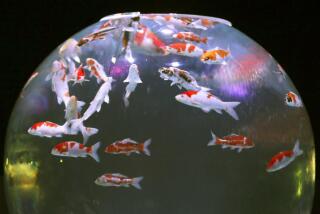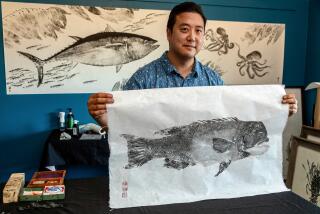Koi in Pond Brings Ripples of Tranquillity
- Share via
American carp are garbage fish good for grinding into gefilte or for denigrating as drowsy targets at bowfishing contests.
They eat weeds like underwater lawn mowers. Their flavor is that of a pincushion dipped in Pennzoil. Carp are a palatable food in Europe and Asia, but that’s where they also consider monkey brains and thymus glands to be good eating.
On the other end of these scales, there’s the koi.
This is the colorful carp (in Japanese, nikishigoi ) known to sell for $100,000, and that’s an awful lot of sushi.
Worth it? A world-class koi is as brilliant and as balanced as anything painted by Matisse. Their reds, blues, yellows and blacks are more coquelicot, cobalt, daffodil and jet.
Looking at small, tropical fish is a known tranquilizer in maternity wards and tax offices. Gazing at a 20-year-old, 36-inch koi--huge, smooth, kaleidoscopic--is close to barbituric.
“When I take people to see my koi, I tell them to be careful because they’ll figure on spending 10 minutes and then blow an hour,” says Bill Ward. He’s the old Asia hand (with the Army in Japan) who manages California Koi Farms just inland from Oceanside at Fallbrook. “Koi and the color patterns they form in the water are a moving art form that mesmerize you until time just disappears.”
Henry Nakamaru of family-owned Asahi Fanci Koi, a Gardena farm that is open to browsers, sees a correlation between koi-watching and professional pressures. “Where there’s a lot of business and problems, there’s a lot of koi,” he says. “We’re sending many koi to Texas these days.”
Koi romp and have personalities. Some prefer classical music. All will grow on a convenient Asian-American diet of rice and hamburger. They can be hand-fed and will not dig up the yard.
Therein, claim breeders and collectors, are reasons for a new surge in popularity of the koi.
--Sales are up 30% in three years, states Ward; with customers coverting swimming pools and wine vats into koi ponds.
--There are a dozen koi clubs in Southern California, regular public events (such as the Fourth Annual Young Fish Show at Mile Square Park, Fountain Valley, today and Sunday) and an estimated 2,500 koi ponds in the state, reports Joe Cuny, of the Southern California Koi Club. Some fanciers, he said, fancy themselves as cosmetic surgeons (trimming color patterns), and one Los Angeles orthodontist is emerging as an expert on koi tumor removals.
“But the thing that has popularized the koi beyond anything else,” explained Ward, “is public awareness that has blown the Rich Man Theory to pieces.”
The Rich Man Theory dictates that car auctions sell nothing but $1- million Duesenbergs, no art collection is complete without a Van Gogh . . . and koi are worth more than their weight in caviar.
“Yet you can buy a plug fish for $5 or $10,” said Cluny. “My wife has won awards with a $15 fish.”
For that, plus the cost of pond, pump and a pound of ground round, a person can be part of a sport of emperors (Genghis Khan imported koi from Persia in the 13th Century) or the hobby of celebrities (Ed McMahon and Willie Nelson) or owner of a piscine talisman said to guarantee wealth, virility and freedom from dandruff.
(For starters, those curious about koi, can call Southern California Koi Club president Joan Finnegan at (714) 548-3690.)
Koi keeping, however, is not without peril.
Herons once descended on California Koi Farms. The tab for their fish dinner was $40,000.
In Southern California, floods and mudslides have carried koi back to public waterways. Ward knows of several in an Oceanside lagoon. Some 90 koi donated to Hollywood’s Wattles Park in 1973 floated away in the rainstorms of 1983.
When returned to nature, koi coloring is likely to revert to sludge brown and algae green.
So beware next time you draw a bead or a bow on a carp.
It could be the $100,000 koi that got away.






